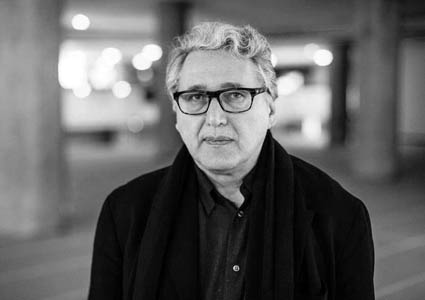张小涛的作品明显有两类,一类作品很“性感”,给人最直接的感觉,是张小涛把性爱中的某种触觉感觉转换成了视觉感觉,画面除了选择做爱的青蛙、鱼、蝌蚪,以及避孕套等明显的“性”符号外,最重要的技巧是一种虚乎乎和黏糊糊的画面处理,尤其是一些抽象的团块造型,如同显微镜下的细胞出现在他所有的画面中:透明粘液状混合着粉红、粉绿斑块状的处理,那是一种不均匀地混合,使粉红、绿斑块状像一种沉淀物,漂浮在黏糊糊的液体中。所以,沉淀物的处理也成为他作品重要的语言因素,画面的沉淀物也成为他生命的沉淀物,呈现出生命体被刺激或者被伤害后的反应,生命的分泌物,死亡的细胞,病毒状的物体,或者伤口的溃烂,沉淀物从他的内心沉淀,蔓延着,沉淀在整个画面,给人一种紧张、脆弱、敏感和担忧的味道。
《116 楼 310 房》和《天堂(老鼠)》等作品,是他的新作,这一类作品超出了与性有关系的感觉,扩展到对周围生活、社会现状的感觉。张小涛说“我所理解的北京‘新生活'是充满着青春的享乐主义和末世的颓废情绪。纵欲过度之后的糜烂图像是令人眩晕的,这些图像对于我来说充满着恐惧感和动荡不安。它们是我们荒诞生活微观片断的抽样放大,也是我们面对这个物质化的欲望社会从心理到生理的本能反应”。画面或许就是这个浮华世界,象酒醉后的眩晕景象,纸醉金迷,灯红酒绿,杯盘狼藉,狗偷鼠窃……
这一类作品中的杯盘狼藉,老鼠,垃圾,腐烂的蛋糕,如同此前画面中的青蛙,金鱼等形象,是一种意象,包括这里展出的忻海洲的作品,都是我称为的意象化语言模式。中国当代艺术中的绘画,是一个比较成熟的媒介,它的标志之一,是把上世纪初引进的西方写实主义绘画,再创造为一种意象化的语言模式。它的形成受到超现实主义的影响,但它不像超现实主义语言模式那样,源于“梦境”,依赖不同时空、不同质的形象变化和组合,达到一种荒诞的效果。意象化的语言模式,依赖的是现实感觉,它使用的具象形,不是带理性色彩的符号化或者象征性的具象,而是与生活体验有关的感觉化的具象。它更接近中国的古典诗词,像“大漠孤烟直,长河落日圆”,在现实物象的“真实”上,同时作为一种人生的境界和体验。或者像中国古典文人画,梅兰竹菊,山水草木,同时也是人的“胸中逸气”的意象。只是当代艺术中的意象化作品,表达的是当代人的生存感觉,没有了传统文人那种典雅的情调,倾向更直接、更露骨甚至不惜更恶心地表达当代人的无聊、压抑、滑稽、荒唐等生存处境。在“绘画死亡”的口号喊了几十年,新媒体被越来越多的艺术家采用的今天,意象化语言模式,为绘画尤其传统绘画的当代转换,展示了新的可能性,也为世界当代艺术提供了一种具有启发意义的话题。
杯盘狼藉,老鼠,垃圾,腐烂的蛋糕,是张小涛的糜烂图像的意象。同时张小涛保持了此前画面虚乎乎的处理办法,以表达糜烂图像令作者眩晕的感觉。其次,张小涛在画面中依然保留了“沉淀物”的语言因素,只是在这里,“沉淀物”不像与性有关的人体分泌物,黏糊糊的感觉在减弱,使“沉淀物”更像“渣滓”,渣滓在杯盘狼藉,老鼠,腐烂的蛋糕意象中,成为一种提示,提示出充满“享乐主义和末世的颓废情绪,纵欲过度之后的糜烂图像”的渣滓特征,这也是张小涛生命中的沉淀物——面对这个物质化的欲望社会,从张小涛心理到生理的本能中沉淀出的“渣滓”。
A striking aspect of Zhang Xiao Tao´s pictures is the way they fall into two categories. One of these is very sensual and the immediate impression they give is as if the haptic in sexuality is transposed into the visual. Here, creatures such as copulating frogs, fish, tadpoles and even condoms are chosen, and here also a particular technique catches our eye: a virtual, distemper treatment of the picture surface and also the abstract, lumpy forms resembling cells under the microscope. These appear in all his pictures; they are as it were witnesses to a specially skilled treatment: a technical hybrid of mucous-form and pale red or green patches of uneven sizes. The result is a strong impression as of developmental precipitations which seem to be swimming in a slimy fluid, and this treatment of these precipitations is the most important semantic factor of both this artist´s pictures and his life. Reactions are to be observed as if in a body after injuries, or deceased cells, viral-like clumps, suppurating wounds. Something is separated, isolated, organises itself and then appears – places itself upon the picture surface. The observer witnesses the exertions of the organic, its transience and sensitivity.
However, the pictures “Room 310, Building 116” (….) and “Paradise (Rat)” (….) are of a quite different and new type. These pictures go beyond feelings connected for instance to sexuality and reach into areas such as life, the environment and social conditions today. Zhang Xiao Tao himself says: “The new life in Beijing, as I see it, is full of youthful hedonism and a depressive mood. Disturbing scenes resembling a hangover after indulgences, giddiness, call up in me feelings of anxiety, unease, confusion. They resemble enlargements of the micro-interfaces of our grotesque life, but at the same time also as instinctive reactions that suggest themselves in view of our materialistically driven life.” These pictures are like an empty magnificent world after a drinking orgy: luxurious, sensual, exorbitant, extravagant, a resplendent mess after a feast or secretive indulgences.
These tables after the feast, rats, refuse, dirt, rotting sweets and cakes, depict again a type of picture language just as do the frogs and the goldfish in the category of “sensual pictures”. To me they appear as the internalization of the painter´s own picture language, (as do Xin Hai Zhou´s pictures). The painting in China´s art presents a sophisticated medium to creatively transpose Western realistic painting – that was introduced there in the last century - into a picture language with intrinsic values. This tendency, while being supported by Surrealism is not merely borrowed from Surrealism´s dream worlds, which are characterised by variations, transformations and combinations of heterogeneous figures from the most differing eras and places – with an aim such as the grotesque.
The internalized intrinsic-value of the picture language however, is dependent upon real feelings and uses real figures that are not merely sketched, without any real colour values, are not symbolised, but rather are loaded with feeling and life experiences. Their idea content lies near to the poetry world of classical China (e.g.: “Straight is the column of smoke upon the endless sand desert, and the sun shines round upon the horizon, where the long river Huanghe disappears…”) In the “realness” of the real appearance of things lies the richness of life and experience. We could also make a connection with the classical drawings of the masters such as the winter blooms “Orchids”, bamboos and chrysanthemums, or the mountain worlds, waterfalls, decorative plants and trees, all of which depict ideas or images about our inner state.
As against these possible connections, the internalized pictures of the contemporary arts express the existential feelings of contemporary people; they do not however contain any of the elegant, distinctive, formal moods of the traditional artist. Rather they tend towards depicting situations such as boredom, depression, the scurrilous, the absurd etc. and this in an undisguised, blunt, even repulsive and horrible manner. Today, where the “death of painting” is announced regularly and the media plays its role in this, the internalized picture language, adopted by contemporary painting and also part of artistic tradition, reveals new possibilities as well as generating stimulation, lessons, themes for discussion.
Chaotic disorder on the dining table, refuse, rats, dirt, rotting cakes – those are some of Zhang Xiao Tao´s images. But he still retains his earlier attitudes towards and treatment of the picture surfaces, in order to express his feeling of giddiness called forth by the dissolute, depraved and dilapidated scenery of the present. And there are still his precipitations. What however has changed is the feeling. The new precipitations no longer consist only of soft materials such as mucous, liquids and secretions, but rather of harder things such as roughage, ejections, refuse. They resemble the precipitations in the painter´s own life and work. Today´s materialistic, consumer society “secretes” dross and scum; out of psychological states physiological reactions are “secreted”: out of foodstuffs, refuse; out of appetite/desire, boredom… Precipitations uniquely caught, pictured and painted by Zhang Xiao Tao.

